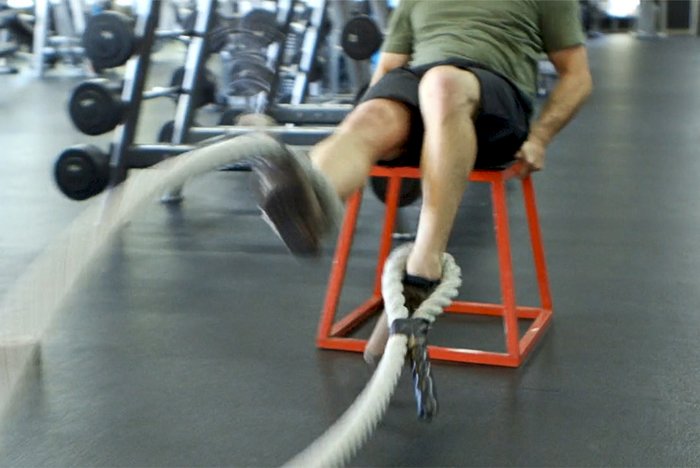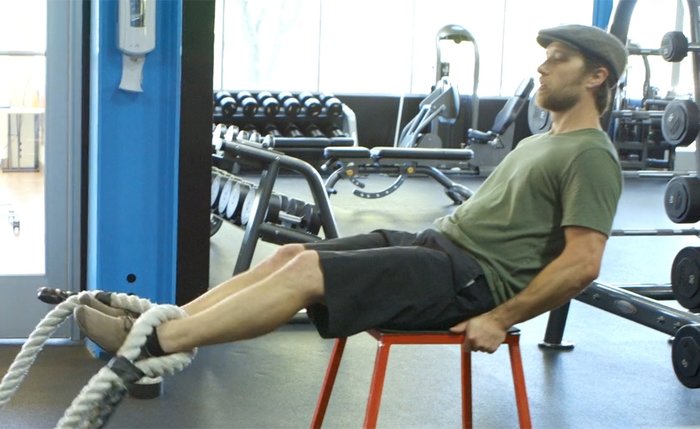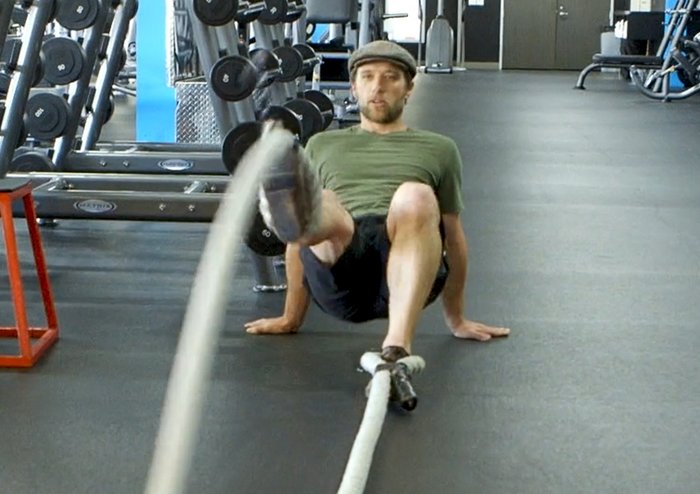The best-known lower-body movements in the gym both ramp up muscle activation, and inflict a fair amount (or a ton) of muscle damage. Squats, for example. Do them hard, and they'll build some serious stumps. They'll also make you sore as hell and limping for a few days.
However, there's another class of movements that also bring serious muscle activation—and serious muscle pump—but don't do much in the way of muscle damage. These are, for lack of a better term, eccentric-free exercises, and they're unique in that they can both build muscle and enhance recovery.
Sled work is one example of a popular eccentric-free leg movement. Cycling is another. Here's one more I can almost guarantee you haven't tried: battle rope leg waves.
Battle ropes for the legs? Hear me out. It's a movement that I haven't seen anywhere else, but I've found immensely beneficial for both myself and my clients. However, I would like to get more people to try it so we can gauge its true value and have a full arsenal of variations.
Ready to do some lower-body beta testing?
Where it came from
My initial experience with battle ropes was back in 2013, when I completed a certification with John Brookfield, the creator of the battling ropes system. Unlike the brief intervals most people are using them for today, we primarily used the ropes at the cert for continuous sets of 1 minute or more. It. Was. Brutal.
It's Brookfield's belief that in training longer intervals, we can teach the body to produce speed and power even in a state of fatigue, as well as building lasting mental toughness. Brookfield has performed rope waves for an hour nonstop—the guy is no slouch.

After the certification, I went back to the gym I was teaching at, determined to mine battle ropes for all they were worth. One day I was talking to a coworker of mine named Jacen Flynn, a one-time contestant on the Ultimate Fighter and a semi-pro MMA athlete at the time, and we agreed that although we loved the ropes we wished there was a similar exercise to develop the legs.
From there, things escalated quickly. The next thing we knew we were duct taping them to our feet and trying to make waves with the ropes. It was seriously challenging…but seriously inconvenient. Soon, we discovered that if we taped loops in the ends of the rope, we could slide our feet in and out, and when we were done we could just take the tape off with no damage to the rope.
Now we were in business. Everyone we introduced this movement to agreed that it was one of the most physically taxing experiences of their lives. Ever since then, I've been practicing and trying to refine the movement. Here are a few lessons I've learned about it:
- I prefer short intervals of 5-12 seconds using full power. Once I start to slow down, I'm finished until the next set.
- Rest breaks should be longer than you think. Treat them like heavy strength work or plyometrics—the traditional kind, not the kind people treat as cardio these days—and rest 3-8 minutes. If you're putting your all into the intervals, you'll be glad for the rest.
- These are much easier on my body then sprinting. They're awful, sure, but the next day you don't feel worn down in the least. This is possibly because there's no impact.
- The pump you get in your legs and core has to be felt. It's different than anything I've had before and seems to come on slowly, 20-30 seconds after the completion of your set. But once you have it, it's hard to shake.
- Performing a few sets of these the day after a hard leg workout or run really speeds up recovery, in my experience. I find I'm able to perform squats, deadlifts, sprints, or long runs more frequently.
- I won't claim any medical knowledge, but there seems to be a benefit to the way power is produced in this exercise. It seems to draw equally from the quads and hamstrings, and produce balanced power and functionality in both. In my experience, nagging issues like IT band syndrome have resolved themselves within weeks of using foot waves.
- Wear shoes. If you don't, you might rub the skin off your foot or ankles. You've been warned.
Battle rope leg waves: four variations
Feel free to come up with your own variations, since this is a new movement to the exercise world. But here are the ones that have been the most useful for me.
Leg kicks: Sit on a box that's 2-3 feet tall with the ropes around your ankles. Lean back slightly and kick your legs furiously. Imagine you've been cast as "victim" in a Jaws reboot and it's time for your big scene.

Straight leg kicks: Sit on a box that's 2-3 feet tall, lean back slightly and, keeping your legs straight, kick your feet as fast as possible. This variation will torch your core.

Crab walk kicks: This variation will work one leg at a time and is useful if you don't have a plyo box to sit on. Slide your feet through the loops, squat down, and place your hands behind you. You are now in a crab-walk position. From here, kick one leg as fast as possible for the desired length of time.

Innie/outie foot waves: Place your feet through the loops, lean back, and move your feet in and out as fast as you can. If you do it correctly, the rope will create waves that travel side-to-side along the ground. You can keep your legs straight, or hold a slight bend at the knees. The farther you lean back, the greater challenge this will pose on your core. This will also develop your inner and outer thighs, possibly preventing the dreaded groin strain.

How to program them
- For power training or active recovery, do 6-10 sets of 5-12 seconds at max power, preferably on a day with no other leg training. I like to program these like a West Side power-focused training day, which has relatively few reps, but many sets.
- For pure leg hypertrophy, do them at the end of a lower-body training session, for fewer sets of a longer duration, like 2-3 sets of 30 seconds or more. But don't be surprised if you feel that tell-tale "I think I'm going puke" feeling somewhere toward the end.
- If you just want to burn some serious calories, you can ratchet the work intervals up to 30 seconds or longer. For the last 10 seconds you may look like a toddler throwing a fit, but you don't care, do you? And yes, this exercise is horribly unfair.
- My wife has gotten into distance running in the last few years and as a consequence, I've been doing a lot more of it myself. I really like to perform 1-2 sessions of foot waves per week for the last 4-8 weeks leading up to a race. My legs feel stronger, and I'm able to maintain a quick turnover with them. I also recover faster from my long runs.
Strap in and go hard
Foot waves are a recovery tool that just might make you faster, stronger, and more resilient. In the process, you just might burn a boatload of calories or add a little beef to your thighs. Yes, people will think you're crazy, but isn't that what a lot of people thought about great moves that quickly became part of the exercise mainstream? Try it, then judge for yourself.
